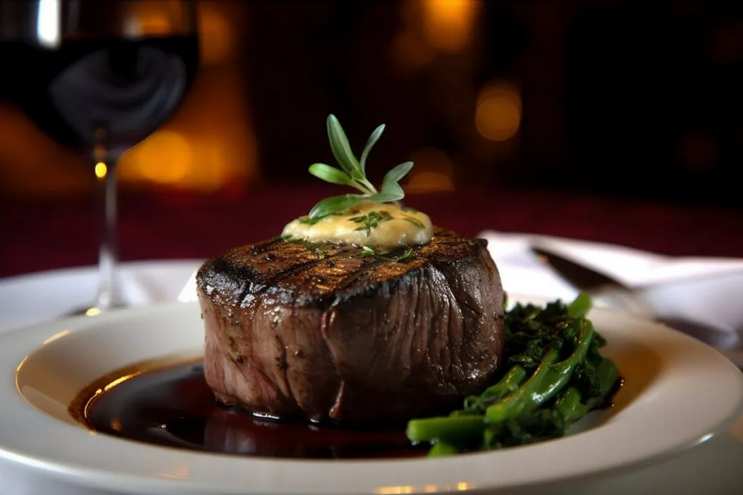Welcome to a world where culinary mastery meets the epitome of steak perfection.
Get ready to tantalize your taste buds with this perfectly seared filet mignon and delectable au jus. It’s a symphony of flavors that promises an unforgettable dining sensation.
This isn’t merely a meal; it’s an experience reserved for those seeking the finest in taste and quality.

Picture the sizzle as the steaks sear, creating a caramelized crust that locks in an explosion of flavors. But this isn’t just any steak; it’s the prized filet mignon, revered for its unparalleled tenderness and exquisite taste.
As you embark on this culinary journey, prepare to be captivated by the art of creating a flawless dish. From the sizzle of the searing pan to the harmonious marriage of flavors in the rich, savory au jus, every step is a testament to culinary finesse.
Perfectly Seared Filet Mignon
Ingredients:
- 4 filet mignon steaks (6-8 oz each), preferably at room temperature
- 2 tablespoons olive oil
- Salt and freshly ground black pepper
- 4 cups beef broth
- 1/2 cup red wine
- 2 cloves garlic, minced
- 1 tablespoon butter
- 1 tablespoon all-purpose flour
- Optional – Horseradish Sauce (see below the recipe)
For the Filet Mignon:
- Prepare the Filet Mignon:
- Preheat the oven to 400°F (200°C).
- Pat the filet mignon dry with paper towels to remove excess moisture. Season both sides generously with salt and pepper.
- Heat a skillet over high heat and add olive oil. Once the oil is hot, sear the steaks for 2-3 minutes on each side until a brown crust forms.
- Transfer the skillet to the preheated oven and cook for an additional 5-7 minutes for medium-rare doneness. Adjust timing for desired doneness: rare, medium, or well-done.
- Make the Au Jus:
- In the same skillet used for the steaks, reduce the heat to medium. Add minced garlic and sauté for a minute until fragrant.
- Sprinkle the flour into the skillet and stir to combine with the pan drippings. Cook for a minute to remove the raw flour taste.
- Slowly pour in the beef broth and red wine, stirring continuously to avoid lumps.
- Let the mixture simmer and reduce by half, stirring occasionally. This will take about 10-15 minutes.
- Stir in the butter until melted and the sauce thickens slightly.
- Serve:
- Once the filet mignon is done, let it rest for a few minutes before serving. Plate the steaks and pour the prepared au jus over them.
I like to make a quick horseradish sauce to top my steak. If you’re interested, here’s the recipe:
Optional Horseradish Sauce to Top Your Perfectly Seared Filet Mignon
Ingredients:
1/2 cup sour cream
2-3 tablespoons prepared horseradish (adjust to taste)
1 tablespoon Dijon mustard
1 teaspoon lemon juice
Salt and freshly ground black pepper to taste
Chopped fresh parsley for garnish (optional)
Instructions:
- In a small mixing bowl, combine the sour cream, prepared horseradish, Dijon mustard, and lemon juice.
- Mix the ingredients thoroughly until well combined.
- Taste the sauce and adjust the seasoning by adding salt and pepper according to your preference. If you prefer a stronger horseradish flavor, you can add more horseradish.
- Once the sauce is well mixed and seasoned to your liking, cover the bowl and refrigerate it for at least 30 minutes before serving to allow the flavors to meld together.
This horseradish sauce adds a delightful zing to the succulent filet mignon, providing a perfect balance of flavors.
Adjust the ingredients according to your taste preferences, especially the horseradish quantity, to achieve your desired level of spiciness and tanginess in the sauce.
For Rare or Well Done Filet:
Rare Filet Mignon
For a rare filet mignon, you’ll want to reduce the time in the oven to achieve the desired level of doneness. Here’s a general guideline:
- Sear the filet mignon steaks for about 2-3 minutes on each side over high heat.
- Then, place the steaks in the preheated oven for approximately 4-5 minutes for rare doneness. This timing can vary based on the thickness of the steaks and your oven, so it’s crucial to use a meat thermometer to ensure it reaches an internal temperature of about 125°F (52°C) for rare.
Well Done Filet
For a well-done filet mignon, you’ll need to extend the cooking time in the oven to ensure the steak reaches the desired doneness. Here’s a general guideline:
- Sear the filet mignon steaks for about 2-3 minutes on each side over high heat.
- Then, place the steaks in the preheated oven for approximately 10-12 minutes for well-done. Again, this timing can vary based on the thickness of the steaks and your oven. Using a meat thermometer is essential, and for well-done, the internal temperature should reach around 160°F (71°C).
Keep in mind that filet mignon is a tender cut, and cooking it to well-done may compromise some of its tenderness and moisture compared to rarer preparations.
Adjust the cooking time based on your personal preference and the specific characteristics of your oven for the desired level of doneness.
 Optional Vegetable Side Dish:
Optional Vegetable Side Dish:
Consider serving the filet mignon with asparagus spears or sautéed spinach for a healthy and delicious side.
Nutrient Notes:
Filet Mignon (6 oz):
- Calories: 300
- Protein: 36g
- Fat: 16g
- Iron: 20% of daily value
Au Jus (1 serving):
- Calories: 50
- Carbohydrates: 4g
- Fat: 2g
- Protein: 2g
Tips and Best Practices:
- Room temperature steaks: Allowing the steaks to come to room temperature before cooking ensures even cooking throughout.
- Searing: High heat is crucial for a good sear on the steaks, which locks in the juices.
- Resting the steaks: Let the cooked steaks rest for a few minutes before slicing to retain their juices.
- Sauce consistency: The au jus should lightly coat the back of a spoon, indicating it’s thickened enough.
- Always remember, it’s best to use a meat thermometer to check for the precise internal temperature rather than relying solely on timing, as it ensures the steak reaches your preferred level of doneness.
Dinner Table Tidbits:
Filet mignon is often referred to as the “king of steaks” due to its tenderness and exquisite flavor. It’s cut from the tenderloin and is among the most expensive and highly prized cuts of beef.
The term “au jus” is French for “with juice” and refers to the flavorful meat juice or sauce served with the dish. Traditionally, it’s made using the drippings from the cooked meat, enhancing the overall dining experience.
The Proper Skillet to Sear the Filet Mignon:
For cooking filet mignon, a skillet that can withstand high heat and provides even heat distribution is ideal. Here are some recommendations:
- Cast Iron Skillet: This is an excellent choice due to its ability to handle high heat and distribute it evenly. It retains heat well, allowing for a good sear on the steak.
- Stainless Steel Skillet: A heavy-bottomed stainless steel skillet is also a good option. It can handle high heat and provides even cooking, though it might require a bit more oil to prevent sticking compared to cast iron.
- Carbon Steel Skillet: Similar to cast iron, carbon steel skillets have excellent heat retention and are suitable for high-temperature cooking.
When using any skillet, it’s essential to preheat it properly before adding the steak to ensure a good sear. Additionally, it’s recommended to avoid nonstick pans for searing the steak, as they might not create the ideal crust due to their lower heat tolerance.
Whichever skillet you choose, make sure it’s large enough to comfortably hold the steaks without overcrowding, as overcrowding can lead to steaming rather than searing the meat.
.
[amazon bestseller=”Cast Iron Skillet” items=”1″]
[amazon bestseller=”stainless steel skillet” items=”1″]
[amazon bestseller=”carbon steel skillet” items=”1″]
 Optional Vegetable Side Dish:
Optional Vegetable Side Dish: